|
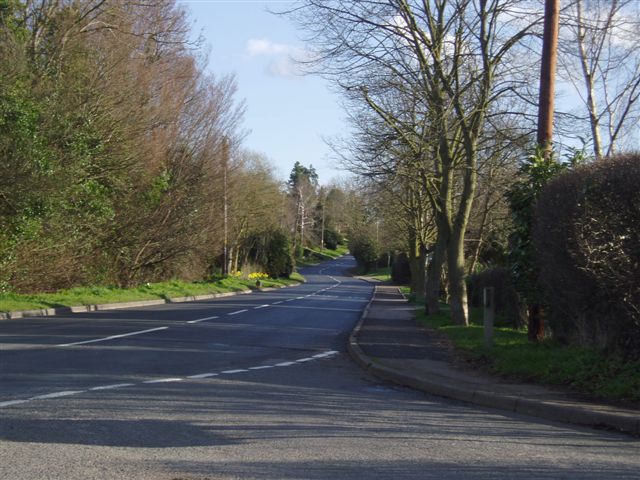
Location
Little Staughton is a small village and civil parish situated ten miles north of Bedford in a pleasant rural area on the boundary with Cambridgeshire. The picturesque village of Kimbolton with its castle (now a school) is four miles to the north and the Cambridgeshire market town of St Neots on the river Ouse is seven miles to the east. Approximately fifteen miles beyond St Neots is the City of Cambridge while Peterborough is twenty miles to the north. Thirty miles to the west is the modern city of Milton Keynes. Trains to London run regularly from Bedford and St Neots. The line from Bedford goes to Leicester, Nottingham and Sheffield while St Neots is on the Great Northern line to Leeds, Newcastle and on north to Scotland. The M1 is approximately 23 miles to the west and the A1 approximately seven miles to the east. The airports of Luton and Stansted are easily accessible.
History
Little Staughton, sometimes referred to as Staughton Parva, is one of Bedfordshire’s “ancient” parishes reputed to have been created before the Norman Conquest. It is not mentioned in the Doomsday Survey but there is a reference to it in a document, dated 1207, involving a land transaction between John de Stockton and the Master of the Templars. This was the first of a series of property transactions involving the Templars who, throughout the thirteenth century, increased their land holding in Little Staughton and the surrounding parishes.
An interesting insight into village life at that time is found in the following recorded incident:
On the evening of 18th June 1271 Hugh le Prest, a felon and outlaw in the county of Lincoln and a murderer in the county of Huntingdon, closely pursued by the sheriffs of these counties and their men, took refuge in the house of Roger, a servant of the Templars, in this parish. His hiding-place was discovered, and, after a brief defence, he was cut down and slain. The hue was then raised, and the two sheriffs having explained to the township the reason for their intrusion, handed over the head of the outlaw and departed. Hugh’s horse was found the next day grazing in a corn-field belonging to the Knights Templar, and was adjudged the property of the township.
When the Order of the Knights Templar was dissolved in the early part of the fourteenth century, the bulk of their property, including that in Little Staughton, passed to the Knights of St John of Jerusalem (The Hospitallers). The Hositallers already had land in the Little Staughton as well as a preceptory in the nearby parish of Melchbourne. Amongst other religious houses which held land in Little Staughton were the Priories of Bushmead and Chicksands.
On the dissolution of the monasteries between 1536 and 1560, the lands in Little Staughton held by the monastic houses passed into the hand of the local gentry. Of these the most important were the Gerys who turned the nearby Bushmead Priory into their home. The Gery and later Wade-Gery family have had a strong link to Little Staughton and many members of the family are buried in the church and its churchyard. (see Monuments). It would have been members of this family who would have occupied the “Squire’s pew” in the church until it was removed in 1900.
From time to time, the village has suffered natural disasters. In 1900.lightening struck and partially demolished the church spire while on 2nd August 1906 the village was hit by a violent storm which caused considerable damage to crops and property. An account of this event was written by John R Newman, a county councillor, and published in the “London Crusader” in September 1906 under the title “A Phenomenal Storm” [Click here to download Microsoft Word version of this account]
During the Second World War, an airfield was constructed at Little Staughton . Although it was only operational between 1942 and 1945, during that time, it saw plenty of action first as a repair base for US B-17s and then, in 1944, as a Pathfinder Station. No 109 (Mosquito) and No 582 (Lancaster) Squadrons of the Royal Air Force were based at Little Staughton between 1944 and 1945 with great distinction. Two airmen, Squadron Leader Robert A M Palmer and Captain Edwin Swales (SAAF) who served at the airfield were awarded the Victoria Cross and the total tally of gallantry awards to crew based there is over 120. Further information about the role of Little Staughton Airfield in the Second World War can be found in Cambridge Airfields in the Second World War by Graham Smith (Countryside Book s 1997). ). It was during the period when the airfield was open to active service that the Baptist Chapel, built in 1776 and located at the end of one of the runways, was hit and seriously damaged by a Mosquito. Until the early 1960s when a new chapel was built on a site closer to the centre of the village, the Baptist congregation used their school room. This, and graveyard, is all that remains of the old chapel. Little Staughton Airfield was closed by the RAF in 1945. The control tower, dispersal areas and runways still remain and light civil aircraft now use the runways. For further information and pictures of the airfield go to www.controltowers.co.uk., Airfield Listing - Little Staughton .
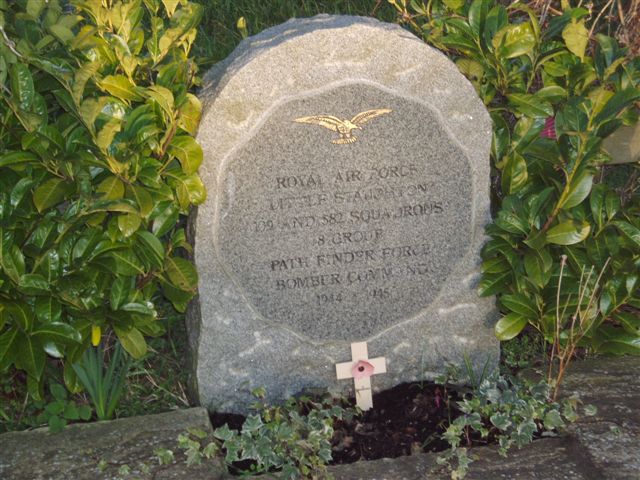
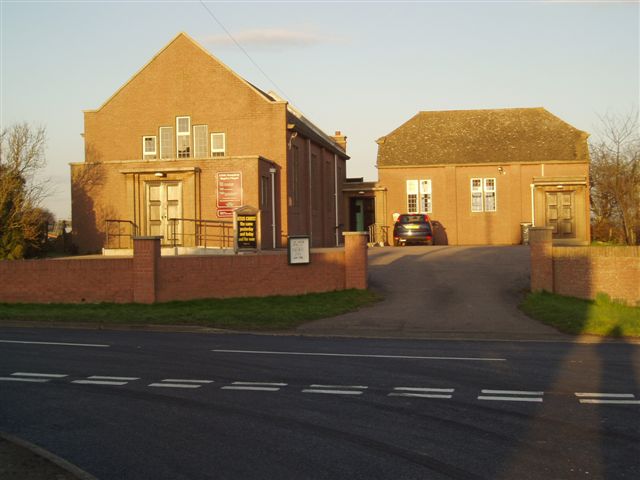
A strong link was forged between those who served in the Pathfinder Squadrons and the village. There is a Pathfinder memorial on the airfield’s perimeter as well as a memorial tablet and Book of Remembrance in the village church (see Book of Remembrance). Until 2005 the Little Staughton Pathfinder Association paid an annual visit to the village. However, on 18th June 2005, the final Reunion and Memorial Service of the Little Staughton Pathfinder Association took place. The preacher and celebrant was Air Vice Marshall The Venerable Ron Heskell CB, Chaplain in Chief to the RAF. The Crests (109 and 582 Squadrons), the RAF and RNZAF Ensigns, the Flags of Canada, Australia and South Africa and the Roll of Honour were presented at the commencement of the service. The Old Testament lesson was read by Joan Greenwood, Chairman of the Association and the Epistle by Tom Thomas, (Ex 109 SQDN). The Dedication was read by Ron Jeffries (Organiser of LSPA) and the Homily by Laurence Binyon. Among the congregation was Air Vice Marshall David Hobart CB, a former Assistant Chief of the Defence Staff. At the conclusion of the service lunch was served in the village hall. Following lunch the members went to the airfield to watch a flypast by a Lancaster bomber and its escort of a Spitfire and Hurricane.
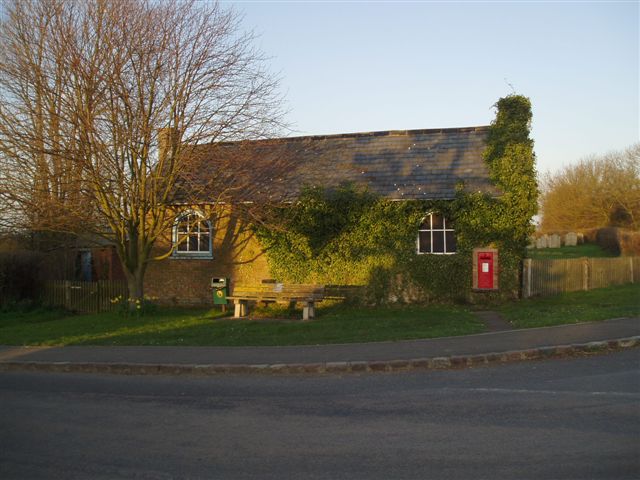
The Village today
The 2001 Census recorded a total population of 421 occupying 176 dwellings. The present Electoral Register contains 378 adults over 17 years of age. The village is under the auspices of Bedford Borough Council but it has its own civil parish council. Although originally an agricultural community, the social make-up of the village has changed and there is an above average percentage of professional and managerial people living in the village who commute to work in London and the other major towns in the area. There are no plans for major housing development in the area and the high standard of the local state schools has made the area attractive, one of the consequences of which is high house prices.
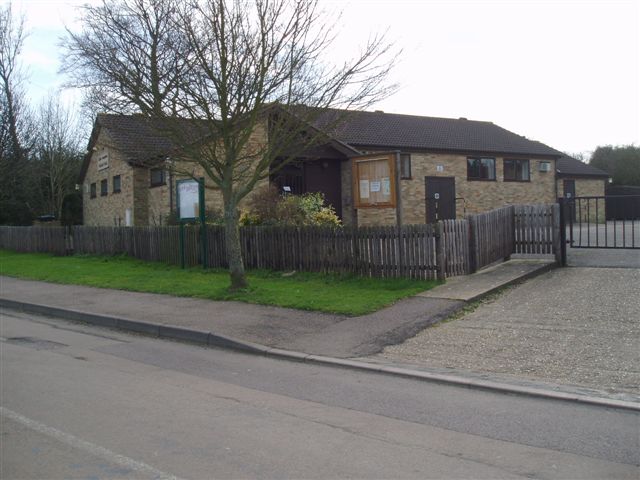
Facilities
The village is fortunate to have a modern village hall (See picture above)which plays an important part in its life by providing facilities for recreational activities across all age groups. There is a village shop, Top End Village Stores, run by Jim, Rachel and Mark and known locally as “McCullums” . In addition to groceries, newspapers, wines and spirits, it also supplies animal feedstuffs, garden plants and shrubs. At the other end of the village is “The Crown”, the local “pub” run by Kevin and Maria and well-known in the locality for its “fish and chips” served on Thursdays and Fridays. It also has its own darts team and holds a fortnightly “Quiz Night”. In the summer months, boules are played on its petanque court. In the centre of the village is Jordans Garage, a motor repair business run by Roger Jordan and the Baptist Chapel where services are held every Sunday. For further information about the Chapel see www.littlestaughtonbaptists.org.uk [NB this website is temporarily down for maintenance. Plese check again at the end of May]. In the neighbouring village of Great Staughton, there is a Post Office and Gilbert Family Butchers. As one travels through the old part of Great Staughton towards Little Staughton, one passes Robin Hood Cottage, home of the Taggart Gallery,which specialises in Victorian tiles, and the renowed Taggart Tile Museum (see www.taggartgallery.co.uk)

|